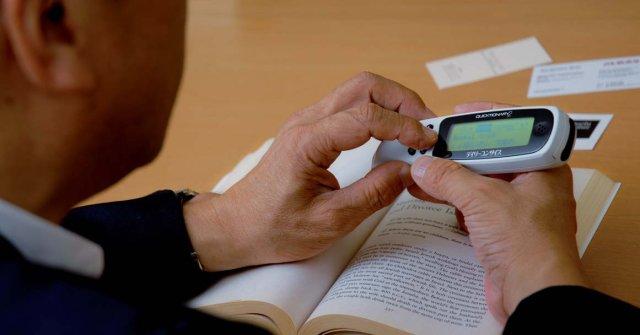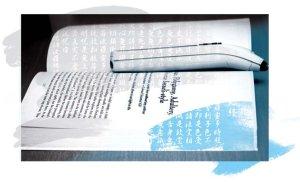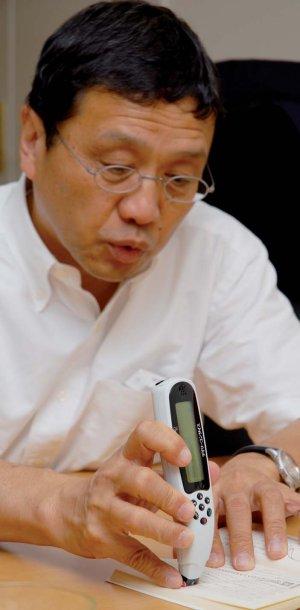No Longer Lost in Translation
 PHOTOGRAPHY: HIROMI IGUCHI (www.hiromiiguchi.com)
PHOTOGRAPHY: HIROMI IGUCHI (www.hiromiiguchi.com)
Innovative scanning dictionary pen to help with the hardest parts of the Japanese language
By Gavin Blair
Every foreigner in Japan has encountered the same brick wall at some time or another—the unknown kanji character. It could be a key word in a newspaper article, an important phrase in a business document or an instruction on a form, but the snag of even a few small kanji may render an entire sentence or paragraph unintelligible. Of course there is always the kanji dictionary and, as long as you can identify the components and count the strokes correctly, it may be sufficient. Yet many who have tried to use those terrifyingly complicated tomes have come to the same conclusion—it may well be easier to memorize a few thousand kanji. Now, there are many electronic dictionaries that have light-pens with which kanji can be inputted onto a mini-screen. Here again though, get the strokes wrong or too far out of proportion, and you’re in the same position.
 The Quicktionary2 Kanji Reader: An ideal gift for all students of Japanese
The Quicktionary2 Kanji Reader: An ideal gift for all students of Japanese
The ideal would be to have a device which allows for quick translation, without the need to mess with buttons, strokes and other tricky obstacles that lie in the way of comprehending an otherwise simple sentence. However, many confused foreigners who feel that kanji might as well be hieroglyphics will be relieved to hear about an innovative new device which successfully cuts out the pitfalls of the old-style dictionary—the Quicktionary2 Kanji Reader pen. The world’s first dictionary pen is a handheld device which is used to scan over the indecipherable kanji, instantaneously displaying the reading and definition of the character on its screen. The pen is produced by Israeli company Wizcom, and has been jointly developed, marketed and distributed by Japan21 Inc since April this year. “I met with Wizcom back in 1999 and I was very impressed with the original Quicktionary product,” explains Mike Kato, CEO of Japan21. At the time it was just an English-to-Japanese dictionary, and Kato proposed that they localize by developing a Japanese-to-English version.
“I had been distributing the old model for seven or eight years and then in April, the Kanji Reader was launched. The technology is based around an Optical Character Recognition (OCR) scanner that has around 3,000 characters programmed into it, which is more than enough for everyday usage” says Kato. The device can scan almost any printed material, including newspapers, magazines, textbooks and printer output, as well as reading font sizes from 6 to 22, both vertically and horizontally.
 Mike Kato, President, Japan21
Mike Kato, President, Japan21
Shortly after the launch of the unit, Japan21 held a competition for users who wrote short essays on how they felt about the Quicktionary2 and what difference it had made to their study of Japanese. Interestingly, the winner of the Gold prize was a 12 year-old Japanese-American girl. “She lives in Hawaii and can speak Japanese very fluently but can’t read kanji so well. The Quicktionary2 allowed her to do homework from her Japanese language school without her mother’s help,” explains Kato.
The Quicktionary2 is not only useful for foreigners living in Japan but is also important for Japanese people who live abroad. It enables them to learn the language properly— a foundation for their cultural identity— and helps returnee Japanese get their kanji up to speed. However Kato affirms that the main market is the large number of people from overseas who can’t read Japanese fluently and find it impacts on their lives to at least some extent on a daily basis.
Mike Kato explains how he ended up working on an Israeli technology venture and how it led to the establishment of his current company: “I first started doing business with Israelis back in ’96, working at a Japanese company but already thinking about leaving. I was working as a consultant to coordinate meetings between them and big Japanese companies like NTT, NEC, Dentsu and many others.”
He spent a week in June 1996 with representatives of an Israeli firm trying to crack the Japanese market. “It was a very busy time but very interesting. The last two or three days they tried to recruit me as a country manager for Japan. I thought to myself that I didn’t know how to work with this strange Israeli video-over-internet startup of around 100 people,” Kato says laughing. “By mid-July I had signed a contract with them, started up the KK in August and had my first order by September.”
The operations of the business started very well with Microsoft investing in the venture as it began to grow. However, not everything was smooth sailing. “The Japan end was the most successful market but the company as a whole was less successful,” reports Kato.
The firm sold off its key R&D unit to a US company and matters deteriorated from there. “The CEO asked me to close the Japan operations but fortunately or unfortunately, the business was too successful in Japan and I felt responsible for the staff and customers here so I told the CEO that I couldn’t do it. I bought out the operation and took over full responsibility for everything. That’s how I became independent,” says Kato.
The people he had worked with around the world eventually provided him with many of the partners he has since worked with. “I also built a big network of overseas contacts who, when they had some business in Japan, would call me and say, ‘Hey Mike, can you help me?’ So this is my job now,” Kato explains.
"I would tell them: Japan is problematic, the culture is different, they don’t speak English so well, it takes too long to get good personnel on-board"
He recalls that even back when the Japanese economy was booming, it was still often very difficult for outsiders trying to penetrate the market: “I would tell them, ‘Japan is problematic, the culture is different, they don’t speak English so well, it takes too long to get good personnel on-board.’ ” Kato believes that country managers want to set up and expand the team but revenue can never grow fast enough. He got around this by setting up his own company “to provide resources and knowledge, basically all the essential things you need to run your business here in Japan.” With a proven track-record and years of experience behind him, Kato is clearly confident in his ability to deliver. After spending ten years with Motorola in Tokyo, Kato believed he had learned many of the rights and wrongs for foreign firms setting up operations here. “Japanese telecommunication deregulation occurred in 1985, so "At that time, being a good English speaker in the Japanese business world had a lot of kudos. Now, effective communication is essential in any business"Motorola had lots of opportunities at the time and 1,000 staff but not a lot of people doing business development. It’s a different culture, it’s not one-to-one sales. In Japan it’s more business-to-business and not a lot of people were willing to put in that level of commitment.” Kato ended up taking on increasing responsibilities to fill the voids that had been allowed to develop. “So I did everything,” he says. “Even though I wasn’t a telecom expert.” He goes on to explain how his language skills made a big difference in those days: “At that time, being a good English speaker in the Japanese business world had a lot of kudos. Now, effective communication is essential in any business, especially when providing a gateway service as I do.”
The combination of Kato’s skills, and knowledge of the challenges faced by companies entering the marketplace in Japan, has been a successful one for his company and its partners. In 2003 this success led to Japan21 being approved for the “Greensheet System” (an alternative sharemarket system sponsored by the Japan Security Dealers Association). “It is still a small company and I would like to keep it as streamlined as possible with a select group of very professional people at its core,” says Kato. Japan21 currently represents and manages the Japanese operations of a number of overseas technology companies working in fields such as biometric security, high-tech communications solutions, semi-conductors, PC-based translation applications, open source software consulting, multimedia processing and delivery, as well as mobile network monitoring and surveillance.
 With the ability to read small and large text, vertically and hozrizontally, the Kanji Reader dictionary pen could become a staple for life in Japan.
With the ability to read small and large text, vertically and hozrizontally, the Kanji Reader dictionary pen could become a staple for life in Japan.
“Being creative is the key to my success in business,” explains Kato. He gives his background of patent licensing in the automotive safety field as well as the product development of the Quicktionary2 Kanji Reader as examples of his creativity. In fact, Kato is a strong believer that creativity is essential for on-the-ground operations and troubleshooting.
After doing business for 30 years, Kato is looking for a new challenge. His future plans include the creation of a fund with the objective of financing M&A deals and bringing innovative ideas to market. “Having experienced the salaryman lifestyle, I know that is not for me. I now concentrate on building true value for businesses, not just as a sales representative or distributor, but from the planning and development stages.” The Quicktionary2 Kanji Reader demonstrates the additional value provided by Kato and Japan21 by being involved at early-stage localization. Kato is constantly searching for new partners, innovative ideas and products to help develop for the Japanese market. JI
Contact Details: Japan21 Inc
Website Kanji Reader: www.kanjireader.net
Website Japan21: www.japan21.co.jp
Email: info@japan21.co.jp
Phone: 03-5456-8540






Comments
Anonymous (not verified)
September 29, 2008 - 16:26
Permalink
20% discount
I am very interested in this product although at first I must admit it sounded too good to be true.
Does the voice speaker also read out loud the pronunciation of the kanji itself?
Kanji Fan (not verified)
October 16, 2008 - 12:22
Permalink
The Kanji Reader's audio function
I have one of these pens. As far as the audio function, it's designed for the English to Japanese mode. But I don't find it necessary in reading Japanese words, as the romanji or hiragana given will show you how to pronounce the words anyway.
Anonymous (not verified)
February 11, 2010 - 06:45
Permalink
So for what do you need after all the pen?
In my opinion, I think it's, sorry to mention it, a stupid comment. So when everything is so clear, why did you buy one of these pens? And I think, if you write such stuff, you are probably at the beginner level, as even quite same written Majiribun somtimes have total different meanings, furthermore, what do you do with a lots of Kanji compositas (like the diet prime minister), for example?
You should be happy as you have such a great help, as I unfortunately do not live in Japan so I probably could order one, which could help me for Japanology education.....
So far, whish you the best for your Japanese studies....
Yuri Anisimov (not verified)
October 1, 2008 - 13:33
Permalink
Kanji Reader
Fantastic. It finally arrived and I can read my bills. 20% discount is welcome
Flying Blind (not verified)
October 10, 2008 - 11:44
Permalink
No Language skills Required?
Hello I am a flight attendant who moved here to Japan for work. I don't speak or read Japanese but felt it was a great opportunity to explore Japan and Asia as a whole. However living in Japan- even part time, without being able to read has proven very difficult. I can't read menus or decipher train schedules or read updates or announcements on the bulletin board in my building. I can't even find the right receipts or read them to figure out how much I paid for a certain item. Would this device help me?
Kanji Fan (not verified)
October 16, 2008 - 12:45
Permalink
Required language skills for Kanji Pen
Good questions. I have one of the Kanji pens and have been experimenting with scanning various things. Hadn't tried store receipts yet, so just tried that and had pretty good results. It is certainly true that life in Japan is still not that easy if you can't read anything.
My personal opinion is that the Kanji Pen is most useful for people who have started studying the language, who know hiragana and katakana, the two syllabaries (which are fairly quick to learn) and have an interest in moving on to the kanji. Yes, you could use the pen on a notice or something, looking up every word, if you are very patient. However, as it's not a translation device, to get the sense of a text, you'd be best off knowing something about Japanese grammar. If you are planning to stay in Japan for any length of time, I really recommend that study, as it makes life so much more interesting and comprehensible.
Anonymous (not verified)
June 1, 2009 - 12:37
Permalink
reading from screens
I just stumbled on this device online and was wondering, can i run it on my mobile screen to translate a japanese word of the text message received, or if i took a picture of a japanese signboard using my digital camera, could i run the dictionary on the display of my camera containing the picture taken of the kanji? Thanks..
unRheal
October 22, 2009 - 09:06
Permalink
Not likely good for screens, but possibly pictures, depending...
Hi,
I'm no authority, but I did read a comment elsewhere while looking for info - where someone asked if it would be good for reading screens, and the reply was that since it worked like a scanner, it wouldn't read from a screen well, if at all. (probably not at all)
As well, it sounded like it wouldn't read handwriting very well, but would read at least a few different popular fonts... so presumably if you took a picture of a sign that was reasonably close to a decent font, and the actual printed picture ended up with the results being in the font-size range it can handle - then it might translate that. But you can probably see how that would be iffy and a bit of hit-miss - unless the picture was taken and (re)sized with this in mind.. and of course would at least have to be printed - and not viewed on your monitor. ;) Cheers.
Anonymous (not verified)
October 22, 2009 - 08:32
Permalink
Sounds great, but...?
I've tried emailing numerous different email addresses I found on wizcomtech.com and wizcomshop.com, but no replies. :(
Anyone know of somewhere in Vancouver, BC, Canada that someone could buy one of these, and ideally actually see one before buying it...?
The "Where to buy" stores they list for Canada don't mention this pen on their sites, that I've found - London Drugs for example - I go into almost every day, but they only carry a single translator by Franklin. :(
And support sure sounds iffy - as I've heard others say, and well... if you can't get a reply to an email, how good is support going to be!?
Thanks! :)
- Andrew
Burnaby, BC, Canada
Alan Bale (not verified)
January 13, 2014 - 03:26
Permalink
translating from art reference books
I collect Japanese art objects and I wish translate from Japanese art reference books that use unusual kanji, sometimes complex ones with unusual definitions in the context of art objects. Will this be possible? Also can the pen read hiragana when it appears above a kanji as a superscript pronunciation help?